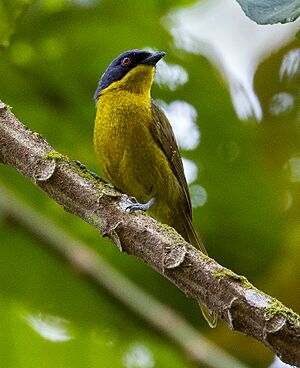Black-fronted bushshrike facts for kids
Quick facts for kids Black-fronted bushshrike |
|
|---|---|
 |
|
| Conservation status | |
| Scientific classification | |
| Genus: |
Chlorophoneus
|
| Species: |
nigrifrons
|
| Synonyms | |
|
|
The black-fronted bushshrike (Chlorophoneus nigrifrons) is a colorful passerine bird. This means it's a type of perching bird. It belongs to the bushshrike family. These birds mostly live in forests in East Africa. It is very similar to the many-colored bushshrike. Sometimes, people even think they are the same species!
Contents
What Does the Black-fronted Bushshrike Look Like?
This bird is about 18 to 19 centimeters long. That's about the length of a pen. It can look quite different from one bird to another. This is because it has several color forms, called morphs.
All black-fronted bushshrikes have green upper parts. They also have a grey crown and upper back. Their tail has a yellow tip. Their bill and legs are dark.
Color Morphs
- Orange morph: This bird has a black mask and forehead. Its underparts are orange. This color fades to yellow under its tail.
- Red morph: This one is similar to the orange morph. But it has more red on its throat and chest. Its belly and undertail-coverts are yellow.
- Buff morph: This bird has buff-colored underparts. Its throat is pale.
- Black morph: This morph has an entirely black face, forehead, throat, and chest. Its belly and undertail-coverts are green.
Female birds are usually not as bright as the males. They have less black on their forehead. Young birds, called juveniles, have buffish underparts. They also have dark stripes. Their wing-feathers have yellow edges.
Bird Song
The song of the black-fronted bushshrike sounds like repeated bells. Pairs of these birds often sing together. This is called dueting.
Where Does the Black-fronted Bushshrike Live?
This bird lives in specific areas. It is found mainly in montane forests. These are forests that grow on mountains. It searches for food in the middle and upper parts of the forest. Outside of the breeding season, these birds often join mixed-species feeding flocks. This means they fly and feed with other types of birds.
Different Groups
There are three main groups, or subspecies, of the black-fronted bushshrike:
- C. n. nigrifrons lives in central Kenya. It also lives south through Tanzania to northern Malawi.
- C. n. manningi is found in the south-eastern part of the Democratic Republic of the Congo. It also lives in northern Zambia.
- C. n. sandgroundi lives in southern Malawi and Mozambique. You can also find it in eastern Zimbabwe and north-eastern South Africa.


